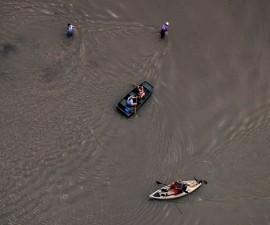MEGAN THOMPSON, PBS NEWSHOUR WEEKEND ANCHOR: Houston is an industrial city, central to the nation's oil and gas industry, and home to one of the busiest ports in the country. It's also home to more than a dozen of the 41 superfund sites in Texas. Those are areas contaminated with toxic waste that the federal Environmental Protection Agency is charged with cleaning up.
This week, reporters from The Associated Press surveyed seven of Houston's superfund sites to assess the damage from Harvey.
AP reporter Michael Biesecker joins us now to discuss this.
I wanted to first ask you, can you just describe us to what these superfund sites are? What are they contaminated with? And are more they more dangerous than the chemical plants and refineries around Houston?
MICHAEL BIESECKER, REPORTER, THE ASSOCIATED PRESS: Well, they're legacy pollution sites. Most were created in the 1950s and 1960s when environmental regulations were much weaker and often because industrial process water they are next to rivers. They're next to lakes. So, these are ducts (ph) and PCBs, heavy metals like lead and arsenic that have been in the soil, in sediment at these sites for decades.
And the EPA's job is to try to clean those up and find responsible parties, the companies who originally caused the pollution and see if they can pay for the clean up. When they can't, taxpayers are on the hook and we pay to clean up the sites as funds become available.
THOMPSON: Can you tell us what did you guys find and what are the threats from the flooding?
BIESECKER: Well, there are about a dozen superfund sites in the greater Houston area. AP's journalists were able to make it to seven of those sites. We prioritize ones we knew we're one in 100-year flood plains which are the areas most likely to flood. And we found all seven have been inundated by water.
Now, you know, the risk posed by these sites depends a lot on what remediation has taken place through the years, has soil and sediment been removed? Have they been capped, often they're capped with a fiber liner that's weighted down with rocks to try to prevent flooding. Both the EPA and environmental watchdogs have been warning about these sites close to waterways for a long time. And they are at risk of flooding.

THOMPSON: The EPA is defensive about your reporting, and today, they put out a statement saying that the article is misleading, they say that they have conducted assessments at 41 sites — that 28 have not been damaged, 13 have been damaged. They say they worked to secure the sites before Harvey hit.
How do you respond?
BIESECKER: Well, you know, EPA can speak for itself, but for their calling our reporting misleading, if you carefully release carefully, they confirm what our reporting said which is, yes, there are 41 sites throughout Texas. Yes, EPA has been able to inspect two sites in Corpus Christi. But in the Houston area which suffered much more dire flooding, EPA has not yet been at those site.
Now, they say from aerial photography that 13 sites appear to have flooded in Texas, including the ones around Houston that we highlighted. But we asked EPA why our reporters were able to make it to these sites and EPA said it was still too dangerous for them to send crews out to assess the damage or to collect samples to monitor whether pollution has spread. They hope to get there next week. Why we were able to make it there and why they weren't, you would have to ask them.
Scott Pruitt, the administrator of EPA, has been on the record saying he thinks that projections of climate scientist, is that hurricanes will be stronger and wetter are alarmist and it's not an issue that at this point, they seem to be planning for addressing. We asked whether Hurricane Harvey had altered Administrator Pruitt's perspective at all on the risk from climate change, the response we got was from an EPA spokeswoman who said that was an effort to politicize the tragedy.
THOMPSON: All right. Michael Biesecker of "The Associated Press", thank you so much for being with us.
BIESECKER: Good to be with you.













